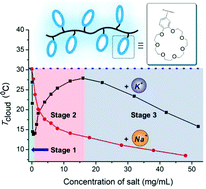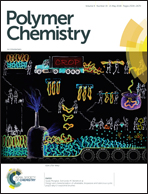Polymeric crown ethers: LCST behavior in water and stimuli-responsiveness†
Abstract
A crown ether-functionalized poly(vinyl alcohol) system that shows lower critical solution temperature (LCST) phase separation behavior in water was developed. In this hybrid polymer–small molecule system, benzo-21-crown-7 units act as signal detectors and receptors, detecting changes of temperature and salt. While PVA backbones act as signal amplifiers. This system can respond to very weak external stimuli and realizes LCST behavior at low temperatures and concentrations. This new system not only displays novel LCST behavior and selective responsiveness, but also overcomes disadvantages of some small molecule-induced LCST systems.



 Please wait while we load your content...
Please wait while we load your content...